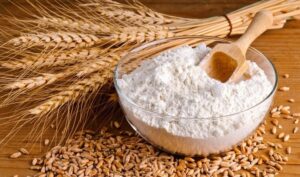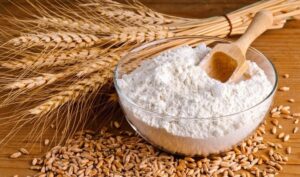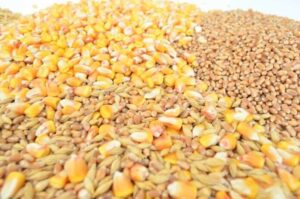
For the first time in 2025, a separate annual quota for the supply of 30,000 tons of Ukrainian flour to the European Union has been granted, which opens up opportunities for long-term planning for the domestic flour milling business, said Rodion Rybchinsky, director of the Ukrainian Flour Millers Association.
“The top 10 export-oriented companies have already invested around EUR 17 million in modernization and now understand that these investments will have prospects,” he said at the “Agribusiness in Ukraine” conference in Kyiv on Thursday.
He recalled that until 2022, flour was exported within the joint quota with wheat. Flour millers usually did not have time to deliver their products to the EU, as grain traders were the first to choose the quota. Only after the opening of trade preferences in 2022 did Ukrainian flour begin to actively enter the EU market, and in 2023, flour exports to EU countries amounted to 73,000 tons.
“These volumes became an argument in the negotiations: if 73,000 tons were successfully delivered to the EU, the question of Ukrainian flour’s non-compliance with European quality requirements would be moot,” said Rybchynskyi.
According to him, Ukrainian flour is now available in Germany, the Czech Republic, Spain, and Italy, which is clear proof of the high quality of Ukrainian products.
Rybchynskyi noted that during the 11 months of 2025, Ukraine supplied 26,000 tons of this product to the EU, so by the end of the year, domestic producers will be able to fully use the quota. At the same time, the biggest problem for flour millers in 2026, if we assess the prospects of the industry, will be the labor shortage.
He named the European Millers’ Congress in France as one of the most anticipated events in the industry next year, during which the Ukrainian side will try to find arguments and establish contact, in particular, with the Romanian Association of Flour Producers, as well as try to lay the groundwork for a review of quotas in 2028. According to Rybchynsky’s estimates, Ukraine is capable of supplying 300,000 tons of flour to the EU market.

Ukraine exported 26,000 tons of wheat flour in the first five months of the 2025-2026 marketing year (MY, July-June), which is 11% less than in the same period of the previous MY. of which 5.4 thousand tons (-7%) were shipped in November, according to the information and analytical agency “APK-Inform.”
Analysts specified that the main volume of exports went to Moldova (30%), the Czech Republic (18%), and Palestine (16%).
“Importers have significantly reduced their purchases of Ukrainian products. For example, Moldova purchased 7.9 thousand tons this season, which is 10% less than in the previous season, and the Czech Republic purchased 4.7 thousand tons (-23%). Palestine reduced its imports, purchasing only 4.3 thousand tons compared to 5.7 thousand tons in the 2024/25 season (-25%),” experts said.
According to their estimates, in July-November 2025/26 MY, Ukraine produced 371.7 thousand tons of flour, which is 8% less than in the same period of 2024/25 MY.
“In general, wheat processing in 2025/26 MY is expected to reach 2.6 million tons, which is 2% less than last season,” APK-Inform predicts.

Since the start of the full-scale war, 88 flour mills have resumed operations in Ukraine, with 22 mills starting operations in 2024 and 10 in 2025, according to Rodion Rybchinsky, director of the Ukrainian Flour Millers Association.
“As of the end of 2021, there were 678 industrial enterprises operating in the grain processing sector in Ukraine. Unfortunately, during the full-scale invasion, we lost 192 enterprises. They either remained in temporarily occupied territories, were completely destroyed and ceased operations, or were partially damaged and suspended operations due to a lack of raw materials and logistics capabilities,” he said at the Agro2Food exhibition in Kyiv on Wednesday.
The expert noted that, starting in 2023, Ukraine began to restore its grain processing industry. Rybchynskyi attributed this to the problem with grain exports in 2022.
“Many agricultural producers saw a way out of the situation in opening grain processing facilities. They invested their funds. In addition, the state began to provide grants for reconstruction and capacity expansion,” he explained.
According to Rybchinsky, since the start of the full-scale war, 66 grain processing enterprises have resumed their work, and 22 enterprises started from scratch in 2024. At the same time, about 10 grain processing enterprises were launched in 2025.
Analyzing the specialization of the new plants, the head of the Ukrainian Flour Millers Association noted that 40% of the new enterprises are engaged in flour production, 30% produce cereals, and another 30% produce pasta. Geographically, the new enterprises are located in western and central Ukraine.
Rybchinsky emphasized that this refers specifically to the construction of new plants, not relocation, as processing enterprises depend on the existing raw material base and consumers. He also noted the complexity of transporting mills and finding new land plots.
According to the head of the Ukrainian Flour Millers Association, the cost of relocating a mill is about $1 million for its owners. According to Rybchynsky, the number of grain processing enterprises that have relocated their facilities can be “counted on the fingers of one hand.”
The expert added that as of 2024, Ukraine had produced 2.34 million tons of flour, which is 22% less than in 2021, before the war, when the country produced 3 million tons.

The total forecast for wheat production in Ukraine for the 2025-2026 marketing year (July-June) is about 21 million tons, of which 10.3 million tons will be food wheat, while the harvest of grade 1-2 grain, which is needed to produce bread-making flour, is forecast at 1.7 million tons, according to Rodion Rybchinsky, chairman of the Ukrainian Millers’ Union.
“We are already seeing growing competition between processors and exporters for high-quality wheat, while farmers, who have the opportunity to store grain for several years, are in no hurry to sell it. This creates risks for price stability and the availability of flour and bakery products for consumers,“ the association’s press service quoted him as saying at the ”Khleb.ua” conference on its Facebook page.
Rybchynsky drew attention to the situation with rye. Domestic production of this crop in Ukraine does not fully cover domestic demand. In 2025/26 MY, flour millers will have to import about 9,000 tons, while in the previous season this figure was 1,600 tons. The expert emphasized that such an increase in imports indicates the formation of a persistent shortage of raw materials.
“The current production structure and behavior of farmers may lead to further increases in flour prices. While the shortage of first- and second-class raw materials already determines the industry’s prospects, the issue of food grain availability poses risks to the country’s food security,” stressed the head of the Ukrainian Millers Association.

Ukrainian producers exported 66,700 tons of wheat flour during the 2024-2025 marketing year (July-June), which is 27.9% less than in the previous season, when this figure was 92,500 tons, according to the Ukrainian Flour Millers Association.
The industry association noted that about 46% of exports in the 2024/2025 season went to EU countries. The top five importers of Ukrainian flour were Moldova (20,300 tons), the Czech Republic (15,300 tons), Palestine (10,800 tons), France (3,000 tons), and Spain (2,900 tons).
Exports of other types of flour in the 2024/2025 season amounted to 4.6 thousand tons (in 2023/24 MY – 5.4 thousand tons). The share of EU countries in terms of export volumes was 14% (27% in 2023/2024 MY). The five countries to which other types of flour were supplied in 2024/25 MY were Moldova (3.2 thousand tons), Israel (0.5 thousand tons), Croatia (0.2 thousand tons), Bulgaria, and Spain (0.1 thousand tons each).
CZECH REPUBLIC, FLOUR, FRANCE, IMPORTER, MOLDOVA, PALESTINE, SPAIN

As of July 1, 2024-2025 marketing year (July-June), Ukraine exported 40.499 mln tonnes of grains and pulses, of which 2.217 mln tonnes were shipped in June, the press service of the Ministry of Agrarian Policy and Food reported, citing data from the State Customs Service.
According to the report, as of June 28 last year, the total shipments were estimated at 50.553 million tons, including 3.621 million tons in June.
According to the preliminary estimates, in 2024/25 season, Ukraine exported 15.704 mln tonnes of wheat (18.3 mln tonnes in 2023/24 MY), 2.318 mln tonnes of barley (2.477 mln tonnes), 10.8 thsd tonnes of rye (1.6 thsd tonnes), and 21.788 mln tonnes of corn (29.233 mln tonnes).
The total exports of Ukrainian flour in 2024/25 MY are estimated at 70.4 thsd tonnes (in 2023/24 MY – 97.8 thsd tonnes), including 65.8 thsd tonnes of wheat (92.4 thsd tonnes).
Thus, in the season-2024/25, the grain exports were down by 19.9% in general, by 14.2% for wheat, by 6.4% for barley, by 25.5% for corn, by 28.1% for flour, including 28.8% for wheat. At the same time, in 2024/25 MY Ukraine increased rye exports by 6.8 times.
As reported, in the season-24/25, the domestic market faced the deficit of rye. Flour mills and bakeries started importing it in winter 2025. The main countries supplying rye and rye flour to Ukraine are the Baltic states and Poland. Industry associations predict that in 2025/26 MY Ukraine will face a 100% deficit of rye due to the further reduction of the production area under this crop. According to experts, this will lead to a 20% rise in bread prices.